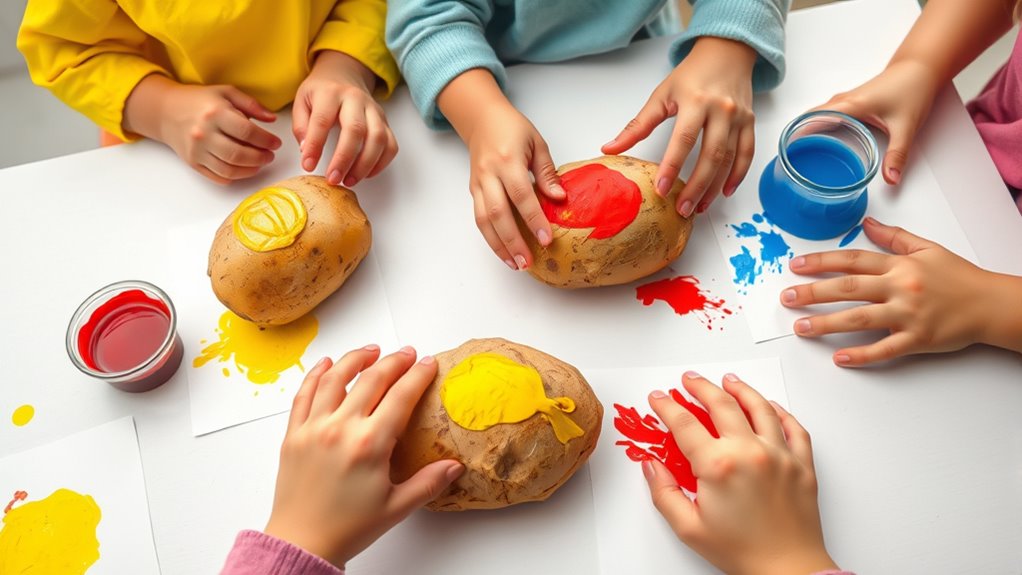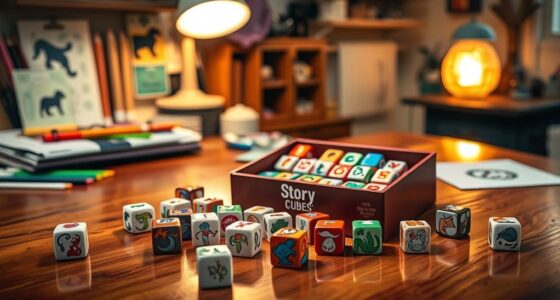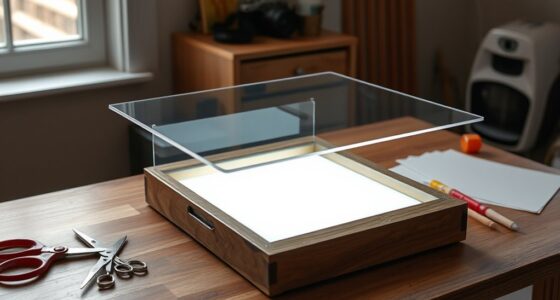You can explore printmaking for kids using everyday objects like sponges, leaves, and textured fabrics to create fun designs and textures. Pressing these items onto paint or ink helps you see how different materials leave unique patterns and colors. Experimenting with objects like foil, combs, or potatoes adds variety and excitement. By trying these simple techniques, you’ll discover how textures and colors blend, making art both engaging and creative. Keep going to learn even more ways to make your prints exciting!
Key Takeaways
- Kids can create unique textures by pressing everyday objects like sponges, leaves, and textured fabrics onto paint or ink.
- Using simple tools such as forks, bottle caps, or textured paper helps children explore different printmaking effects easily.
- Mixing colors directly on prints or palettes allows kids to experiment with blending and discovering new hues.
- Hands-on activities with household items encourage creativity, sensory exploration, and confidence in art-making.
- Printmaking with everyday objects fosters understanding of textures, colors, and materials while offering a fun, accessible art experience.

Printmaking is a fun and creative activity that lets kids explore their artistic talents while making unique artworks. When you try printmaking with everyday objects, you open the door to a world of texture exploration and color mixing. These techniques allow you to experiment and discover new ways to express yourself through art, all while having fun with simple materials you already have at home.
One of the first things you’ll notice during printmaking is how different objects create various textures. For example, a piece of sponge, a leaf, or a textured fabric can leave distinct patterns on paper or fabric. As you press these objects onto paint or ink, you can see how their surface textures transfer, giving your artwork a tactile quality that’s both interesting and unique. Texture exploration becomes an exciting part of the process because every object offers a different visual and sensory experience. You might press a crumpled piece of foil to make a rough, metallic-looking pattern or use a comb or fork to add fine lines and detail. This hands-on approach encourages curiosity and helps you understand how materials and textures work together in art.
Different objects create unique textures, making each print an interesting, tactile work of art.
Color mixing is another crucial aspect of printmaking with everyday objects. When you apply paint or ink to the objects, you get to experiment with blending different colors. You can try mixing primary colors like red, blue, and yellow directly on your palette or even on the print itself to see how they combine. For instance, pressing a leaf dipped in yellow and red ink can produce a warm orange hue. By overlapping prints with different colors, you learn about color relationships and how new shades emerge. This process not only enhances your understanding of color mixing but also adds vibrancy and depth to your artwork. It’s fascinating to see how simple objects can produce complex and beautiful color variations, giving your prints a lively, dynamic appearance.
Using everyday objects for printmaking encourages you to think creatively about what materials can be turned into tools. You might experiment with sponges, bottle caps, textured paper, or even potatoes—each offering different textures and color effects. As you explore, you’ll learn how the pressure applied during printing affects the clarity and detail of your designs. The more you experiment, the more confident you’ll become in controlling textures and colors to achieve the desired effect.
Frequently Asked Questions
What Safety Precautions Should I Take During Printmaking Activities?
You should always supervise children closely during printmaking to guarantee safety, especially with sharp tools or inks. Create a safe workspace by keeping hazards away and using non-toxic, child-friendly materials. Make sure kids wear aprons or old clothes to protect their skin and clothing. Keep a first aid kit nearby, and teach children to handle supplies carefully. By maintaining supervision and a safe environment, you help prevent accidents and make the activity enjoyable.
How Can I Adapt Printmaking for Children With Special Needs?
You can adapt printmaking for children with special needs by incorporating adaptive techniques and sensory-friendly tools. Use textured stamps or soft inks to engage different senses, and provide easy-to-hold tools for better grip. Simplify steps and offer visual supports to help understanding. Allow extra time and create a calm environment, ensuring each child feels comfortable and confident while exploring printmaking creatively and safely.
What Are Some Eco-Friendly Materials for Printmaking Projects?
Like a gentle breeze, eco-friendly materials breathe life into your printmaking projects. You can use recycled paper, which is as versatile as new, and biodegradable inks that break down naturally. These materials are safe for kids and the environment, making your art sustainable. By choosing recycled and biodegradable options, you guarantee your creative process leaves a positive impact, nurturing both young artists and our planet.
How Do I Store and Preserve Kids’ Print Artwork?
To store and preserve kids’ print artwork, you should focus on artwork organization with clear, labeled folders or portfolios. Use preservation techniques like flat storage in acid-free sleeves or boxes to prevent damage. Avoid folding or rolling. For long-term display, consider scanning or photographing the prints. Keep the storage environment stable—cool, dry, and away from direct sunlight—to guarantee the artwork stays vibrant and intact over time.
Can Printmaking Be Integrated Into Classroom Curriculum Effectively?
Yes, printmaking easily integrates into your classroom curriculum, enhancing art education and fostering creativity. You can incorporate printmaking as part of art integration by linking it to history, science, or literacy lessons, making learning more engaging. It encourages hands-on participation, helping students explore different techniques while reinforcing curriculum goals. This approach not only boosts artistic skills but also promotes critical thinking, making printmaking a valuable tool for curriculum enhancement.
Conclusion
Now that you’ve explored printmaking with everyday objects, remember that creativity turns simple things into art. Just like a painter sees a blank canvas, you see potential in everyday items. Keep experimenting, and you’ll find that “a picture is worth a thousand words,” especially when your own prints tell stories. So, go ahead—grab some objects, make your mark, and watch your imagination come to life!









